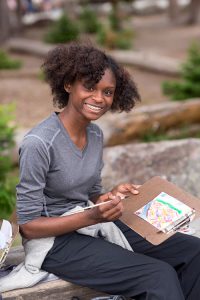By Lucia Whalen
Medill Reports
The summer before college, most 18-year-olds work summer jobs, attend music festivals and spend their final days at home with friends before heading off to their first year of independence.
Patricia Joyner is not most 18-year-olds. Over the summer, Joyner, a recent graduate of Gary Comer College Prep high school in Chicago and an incoming college freshman, joined a team of University of Maine scientists to track the retreat of the glaciers and how those past changes can give clues to global climate triggers and what human-made global warming might mean for us now.

While youth activists such as Greta Thunberg are making headlines around the world for taking a stance and speaking up about the politics of climate change, Joyner represents an equally important yet less publicized group – the next generation of climate scientists. She is studying environmental science at the University of Maine with the scientists who led the research trip.
Joyner traces her interest in climate science to her high school environmental science teacher Jessica Stevens at Gary Comer Prep. Stevens, who also participated in the Mongolia trip, said she first identified Joyner as a possible candidate to sign on for the expedition with scientist Aaron Putnam when Joyner was a freshman. But until she was at least a junior, she could not able to attend the earlier treks.
Focused on continuing to work and learn outdoors while in high school, Joyner joined the Green Teens program through the Gary Comer Youth Center. The center organizes yearly camping trips to Yellowstone National Park, which gave Joyner basic training, without her realizing, in the outdoor skills that would later serve her in Mongolia. The yearly trips to Yellowstone helped clarify for Joyner her desire to pursue a path in science.
“I did that and was like, ‘Okay, this is what I want to be doing.’ I like working out in the field. It was just fun,” Joyner said.
Joyner’s investment in the yearly outdoor expeditions to Yellowstone and work with the youth center caught the attention of her teachers and Stevens recommended her for Putnam’s Mongolia expedition, supported by a grant from the National Science Foundation that funded Youth Center student participation. Just before leaving for Mongolia, Joyner traveled to Rwanda with the program Peace Exchange, which trains youth leaders in peace and nonviolence overseas.

While in Mongolia, Joyner helped the team of University of Maine scientists collect rock samples and drill boulders for later research on the connection between glacial movement and climate.
Joyner’s drive and interdisciplinary interests mirror that of the next generation of youth stepping into leadership positions and fields related to the climate crisis.
“When I originally thought about science, I thought it was this linear thing. But once I started learning and investing myself in it, I realized so many [related] things [like] the law,” Joyner said. “I just thought it was [it was going to be] boring. Until I realized that I can be a part of it, and that it is fun, especially the field work.”
Joyner started her freshman year at the University of Maine with a scholarship and has a lab research position studying with Putnam and Ph.D. student Peter Strand, another of the scientists on the trek to Mongolia.
Joyner plans to eventually combine her training in peacekeeping and politics with her passion for the outdoors and climate change research into a career in environmental law. She is already in a university club that prepares students for the LSAT.
Joyner wants to eventually bring her knowledge and experiences back to Chicago. “Right now I feel like this is the time for me to learn as much as I can. And once I’m able to learn as much as I can, I’ll be able to utilize it and help where I’m from,” Joyner said.
Patricia Joyner (right) and Stephanie Comer, president of the Comer Family Foundation, use an iPad to track the “skyline” in Mongolia. (Photo by Stephanie Fox)


